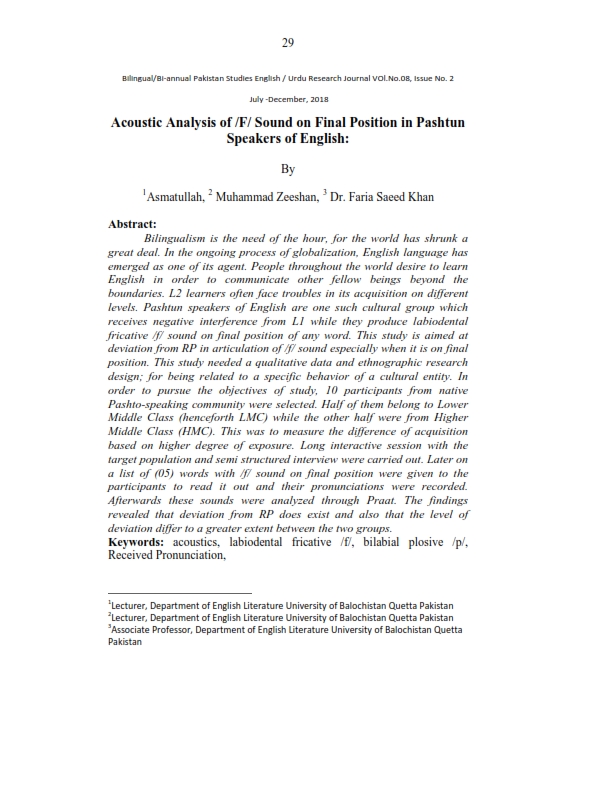Acoustic Analysis of /F/ Sound on Final Position in Pashtun Speakers of English:
Keywords:
acoustics, labiodental fricative /f/, bilabial plosive /p/, Received Pronunciation,Abstract
Bilingualism is the need of the hour, for the world has shrunk a
great deal. In the ongoing process of globalization, English language has
emerged as one of its agent. People throughout the world desire to learn
English in order to communicate other fellow beings beyond the
boundaries. L2 learners often face troubles in its acquisition on different
levels. Pashtun speakers of English are one such cultural group which
receives negative interference from L1 while they produce labiodental
fricative /f/ sound on final position of any word. This study is aimed at
deviation from RP in articulation of /f/ sound especially when it is on final
position. This study needed a qualitative data and ethnographic research
design; for being related to a specific behavior of a cultural entity. In
order to pursue the objectives of study, 10 participants from native
Pashto-speaking community were selected. Half of them belong to Lower
Middle Class (henceforth LMC) while the other half were from Higher
Middle Class (HMC). This was to measure the difference of acquisition
based on higher degree of exposure. Long interactive session with the
target population and semi structured interview were carried out. Later on
a list of (05) words with /f/ sound on final position were given to the
participants to read it out and their pronunciations were recorded.
Afterwards these sounds were analyzed through Praat. The findings
revealed that deviation from RP does exist and also that the level of
deviation differ to a greater extent between the two groups.
References
Ali, S. (2013). The Problem of /f/ and /p/ in stuents of Master Level in
AWKUM. SBBU, Upper Dir , 1-9.
Amin, M. (2016). Investigating the grammatical problems of non-English
major students of university of Balochistan in writing
argumentative essays in Enlgish. thesis .
Creswell, J. W. (2013). Research Design. Research Design, Qualitative,
Quantitative and Mix Methods Approaches . New
Delhi, India: Sage Publications.
Dornyei, Z. (2007). Research Mehtod in Applied Linguistics. Oxford
Unversity Press .
Ghani Rehman & Riazudding . (2011). The Acoustic Analysis of Pashto
Vowels. language in India , 793-97.
Ghani Rehman, Mohammad Iqbal. (2016, January to June ). Comparative
Study of Pashto and English Consonants. Pashto , pp.
-27.
Henderson, M. M. (1998). Sample phonology i term paper the phonology
of pashto .citeseerx , 1-4.
Holdcroft, D. (1991). Moder European Philosophy; Saussur sign, system
and arbitrariness . Cambridge: Cambridge University
press.
Ijaz, M. (2003-04). The Phonemic Inventory of Pashto. CRULP , 83-88.
Ilker Etikan, Kabiru Bala. (2017). Sampling and Sampling Methods.
Biometeric and Biostatics International Journal , 1-3.
Irfanullah. (2011). 1. The impact of ‘phonological characteristics The
Impacts of Pashto’ and ‘native English environment’ on
the pronunciation of English consonants. The MIddle
Sex University , 1-80.
Khalilzadeh, A. (2014). Phonetic and non-phonetic languages: a
contrastive study of english and turkish phonology
focusing on the orthography induced pronunciation
problem of turkish learners of english as
efl.International journal of Languages, Education and
Teaching , 1-16.
L R Gay, Geoffery E. Mills, Peter W. Airasian. (2012). Education
Researhc. Boston: Pearson .
Lieshout, P. v. (2017). PRAAT Short Tutorial. University of Toronto , 1-
M. Naci kayaoğlu & nuray çaylak. (2013). What is Needed for Correct
Pronunciation: A Model Or Concern? Eurasian Journal
of Educational Research, Issue 53, , 269-290.
Marc Haber, Daniel E. Platt,Maziar Ashrafian Bonab, Sonia C. Youhanna,
David F. Soria-Hernanz & Begona Martinez-Cruz.
(2012). Afghanistan's Ethnic Groups Share a YChrosomal Heritage Structured by Historical Events.
Kabul: Genome Research Limted.
María Isabel Maldonado García & Bakht Munir. (2016). Origin of Pashto
language and Different Phases of Its Literary Evolution.
journal of the research (humanities) , 145-167.
Maria Isabel Maldonado Gracia & Bakht Munir. (2016). Origin of Pashto
Language and Different Phases of its Literary
evolution. Journal of the Research (humanities) , 145-
Megan Keilty, Gina L. Harrison. (2015). Linguistic and Literacy
Predictors of Early Spelling in First and Second
Language Learners. Canadian Journal of Applied
Linguistics , 87-106.
Nag, O. S. (2017, April 25). Society. Retrieved september 6, 2017, from
Worldatlas: http://www.worldatlas.com/articles/whatlanguages-are-spoken-in-pakistan.html
Nath, D. B. (2010). Major Language Theorists influencing Learning of
Mathematics. University of Kalicut , 1-13.
Oatizs, R. (1998). Transforming qualitative information: thematic analysis
code development. Thousand Oaks .
Rehman, Riazudding & Ghani. (2011). The Acoustic Analysis of Pashto
Vowels. language in India , 793-97.
Rehman, T. (2014). Pakistani English. Islamabad:
https://www.academia.edu/7846520/Pakistani_English_
By_Tariq_Rehman.
Rohit Prasad, Stavros Tsakalidis, Ivan Bulyko, Chia-lin Kao, Prem
Natarajan. (2010). Pashto speech recognition with
limited pronunciation lexicon.BBN Technologies, 10
Moulton St., Cambridge, MA 02138 , 5086-89.
Rzehak, L. (2012). Inequality in Equality: Linguistic Convergence
Between Dari and Pashto. Afghanistan Analysts
Network .
Sipra, M. A. (2013). The impact of orthography on the acquisition of L2
phonology: inferring the wrong phonology from print.
Canadian Center of Science and Education , 116-124.
Thompson, I. (2015, august 7). Editor Picks, Pashto. Retrieved november
, 2017, from about world languages:
http://aboutworldlanguages.com/pashto
Thomson, D. D. (1970). Factors Related to the Pronunciation of Vowel
Clusters. ERIC , 1-198.
Timonen, O. K. (october, 2012). Encounter in Zembian Children's Home...
ethnographic study of volunteer tourism. University of
Helsinki , 1-96.
Wazir, D. N. (2013). Da Waziri Lehjey Doad. Takatoo , 10-27.
Yan, H. (2008). The Meanin of “meaning”: Reflection on linguistic
school’s theoretical descrition of meanin in translation.
US-China Education Review, volume # 5 , 34-42.
Zeeshan, M. (2013). Pakistani Government Secondary School Teachers’
and Students’ Attitudes. PQDT Open , 1-100.



